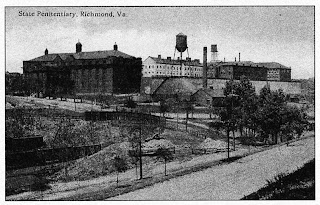kw: book reviews, nonfiction, history, post-civil war, folk songs, archetypes
Almost everyone knows the first verse:
John Henry was a little baby
Sittin' on his Mammy's knee
He picked up a hammer and a little piece of steel.
Said, "Hammer's gonna be the death of me (Lord, Lord)
Hammer's gonna be the death of me."
 This block print by Frank W. Long is the cover art for Steel Drivin' Man—John Henry—The Untold Story of an American Legend. Scott Reynolds Nelson, of the College of William and Mary, has done his detective work and produced a very readable account of John Henry, his life and times in post-Civil War Virginia and West Virginia, the songs that followed his memory, and the icon he has become, to a greater variety of causes than any one man.
This block print by Frank W. Long is the cover art for Steel Drivin' Man—John Henry—The Untold Story of an American Legend. Scott Reynolds Nelson, of the College of William and Mary, has done his detective work and produced a very readable account of John Henry, his life and times in post-Civil War Virginia and West Virginia, the songs that followed his memory, and the icon he has become, to a greater variety of causes than any one man.
Most people know that John Henry was black, a hammer man for the C&O Railroad, who died on the job. Whether he was in a race with a steam drill at the time is debatable, even after we peruse the documentary and anecdotal evidence. But who knew he was from New Jersey, or that he was just an inch over five feet tall? Actually, his small stature ensured his place in the tunnels; he was just the right size.
The story of his life isn't pretty. Convicted of theft, sentenced to ten years—a death sentence, effectively. As Virginia reeled under the economic disaster of Radical Reconstruction, John Henry and hundreds like him were sent to work as convict labor on the railroads. The free miners could strike and demand better working conditions. Convicts couldn't. Those that didn't die of overwork died of silicosis, particularly in the Lewis Tunnel, where John Henry died, probably in 1873.
The railroad was trying to cut costs, and brought in various steam drills. These early drills were inefficient and slow. The convicts regularly out-drilled them. But working alongside a steam drill was worse than working with another crew; the steam drills made much more sandy dust. Lewis Tunnel had the sandiest rock, and few hammer men lived a year before their lungs just gave out.
 After John Henry died, his fate was like that of hundreds of others:
After John Henry died, his fate was like that of hundreds of others:
They took John Henry to the white house
And buried him in the sand
And every locomotive come roarin' by
Says, "There lays that steel-drivin' man (Oh, Lord)
There lays that steel-drivin' man."
Click on this image of an old postcard (from page 36 of the book) to see it larger. The "white house" was the white structure behind the water tower. Late-20th-Century excavations found the remains of at least 300 anonymous convicts in a large sandy plot alongside the "white house".
This brings us to the halfway point in the book. What has happened to John Henry since 1874? Plenty! His story was incomporated into "hammer songs", used by the workers to synchronize a team's work, and to keep them from working too fast. Even their foremen knew it was a false economy to work too fast and burn out before day's end.
Matter of fact, all that literature we grew up with, talking of "happy darkies singing as they work" is nonsense. Like sea chanties, work songs in general are sad, even depressing, filled with resentment of "the man", and intended to keep the work at a steady pace, not to cheer anyone up. They are the source of the Blues, and why real Blues tunes are slow. Their message is, "Don't kill yourself. Slow down."
First Carl Sandburg, then a series of "progressive" (read, socialist) performers turned John Henry into a muscular icon of the sanctified proletarian. Early comics illustrated bowdlerized versions of his life and others. Through the 1930s, the muscular heroes lost their color and morphed into Superman and Captain America.
John Henry remains the subject of more folk songs than anyone else. We owe a debt to author Nelson, to remember John Henry as he was, and let him symbolize the convict labor, sent under "black laws" to die for the building of the railroads.



No comments:
Post a Comment